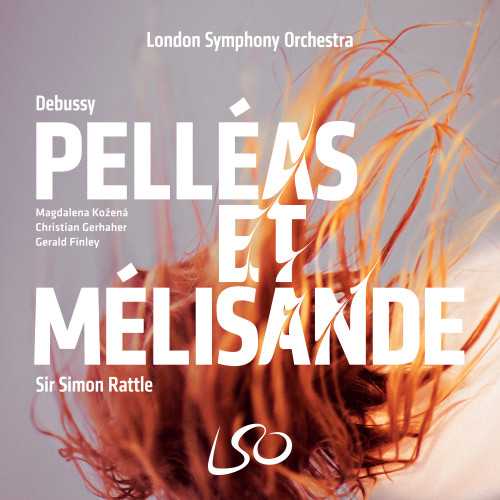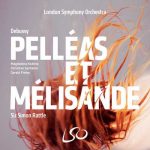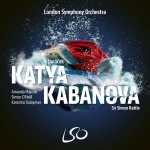
Composer: Claude Debussy
Orchestra: London Symphony Orchestra
Conductor: Sir Simon Rattle
Audio CD
Number of Discs: 3
Format: DSD128 (dsf tracks)
Label: LSO
Size: 6.56 GB
Recovery: +3%
Scan: yes
Magdalena Kožená, Mélisande
Christian Gerhaher, Pelléas
Gerald Finley, Golaud
Franz-Josef Selig, Arkël
Bernarda Fink, Geneviève
Joshua Bloom, The Doctor, The Shepherd
Elias Mädler, Yniold
Simon Halsey, chorus director
Pelléas et Mélisande
Act I
01. Scène 1 Une forêt – “Je ne pourrais plus sortir” (Golaud, Méilisande)
02. “Pourquoi pleures-toi?” (Méilisande, Golaud)
03. Interlude
04. Scène 2 Un appartement dans le château – “Voici ce qu’il écrit à son frère” (Geneviève)
05. “Qu’en dites-vous?” (Pelléas, Geneviève, Arkël)
06. Interlude
07. Scène 3 Devant le château – “Il fait sombre dans les jardins” (Pelléas, Geneviève, Méilisande)
08. “Hoé hisse Hoé!” (Pelléas, Geneviève, Méilisande, sailors)
Act II
09. Scène 1 Une fontaine dans le parc – “Vous ne savez pas où je vous ai menée?” (Pelléas, Méilisande)
10. “C’est au bord d’une fontaine” (Pelléas, Méilisande)
11. Interlude
12. Scène 2 Un appartement dans le château – “Ah! Ah! Tout va bien” (Mélisande, Golaud)
13. “Tiens, Où est l’anneau que he t’avais donné” (Mélisande, Golaud)
14. Interlude
15. Scène 3 Devant une grotte – “Oui; c’est ici nous y sommes” (Pelléas, Mélisande)
Act III
16. Scène 1 Une des tours du château – “Mes longs cheveux descendent” (Pelléas, Mélisande)
17. “Je les tiens dans le mains” (Pelléas, Mélisande)
18. “Que faites-vous ici?” (Pelléas, Golaud)
19. Scène 2 Les souterrains du château – “Prenez garde, par ici” (Pelléas, Golaud)
20. Scène 3 Une terrasse au sortir des souterrains – “Ah, je respire en fin!” Pelléas, Golaud)
21. Interlude
22. Scène 4 Devant le château – “Viens, nous allons nous asseoir ici” (Golaud, Yniold)
23. “Qu’ils s’embrassent, petit père?” (Golaud, Yniold)
Act IV
24. Scène 1 Un appartement dans le château – “Oùvas-tu?” (Pelléas, Mélisande)
25. Scène 2 “Maintenant que le père de Pelléas” (Mélisande, Arkël)
26. “Pelléas part ce soir” (Mélisande, Golaud, Arkél)
27. “Ne mettez pas ainsi votre main à la gorge” (Mélisande, Golaud, Arkël)
28. Interlude
29. Scène 3 Une fontaine dans le parc – “Oh! Cette pierre est lourde” (Yniold, The Shepherd)
30. Scène 4 “C’est le dernier soir” (Pelléas, Mélisande)
31. “Nous sommes venus ici il y a bien longtemps (Pelléas, Mélisande)
32. “On dirait que ta voix” (Pelléas, Mélisande)
33. “Quel est ce bruit?” (Pelléas, Mélisande)
Act V
34. Scène 1 Une chambre dans le château – “Ce n’est pas de cette petite blessure” (Golaud, The Doctor, Arkël)
35. “Attention, je crois qu’elle s’éveille” (Mélisande, Golaud, The Doctor, Arkël)
36. “Mélisande, as-tu pitié de moi?” (Mélisande, Golaud)
37. “Non, non nous n’avons pas été coupables” (Mélisande, Golaud)
38. “Qu’avez-vous-fait?” (Mélisande, Golaud, Arkël)
39. “Qu’y’ a-t-il?” (Golaud, The Doctor, Arkël)
40. “Attention… attention!” (Golaud, Arkël, The Doctor)
rattle_debussy_pelleas_et_melisande_sacd_part02.rar – 3.3 GB
Sir Simon Rattle leads an all-star cast in this highly-anticipated new recording of Debussy’s evocative opera Pelléas et Mélisande. It was captured in January 2016 during performances of an innovative collaboration between Rattle & Peter Sellars, 2 of the boldest creative minds in music & theatre today. Supported by the London Symphony Chorus, prepared by renowned choral director Simon Halsey, it is a moving statement of intent for Rattle’s tenure as LSO Music Director. The plot, a love triangle between Prince Golaud, his wife Mélisande & his brother Pelléas, is shrouded in mystery & full of gripping twists & emotion-filled turns, ultimately ending in Pelléas untimely death. The sensuous score contains some of Debussy’s most exquisite music & perfectly crystallises the atmosphere of Maeterlinck’s original play. Debussy himself explained the appeal of the work: “The drama of Pelléas which, despite its dream like atmosphere, contains far more humanity than those so-called ‘real life documents’, seemed to suit my intentions admirably. In it there is an evocative language whose sensitivity could be extended into music & into the orchestral backcloth.”
Debussy completed only one opera, but it was quickly recognised as a masterpiece and indeed one of the great 20th-century works in the form. He took a long time, however, both to discover the right subject and to compose the piece. (…)
For all that, Pelléas is one of the most original and influential operas of its period. Its atmosphere is distinctive and indeed unique, a self-enclosed world where the characters often say one thing when they mean quite another. This sense of ambiguity is highlighted by Debussy’s complex and subtle harmony and his delicate use of orchestral colour throughout. Ironically, Maeterlinck’s play has largely disappeared from view – as if Debussy, in providing its precise musical equivalent, had left no need for it to continue to be performed. While we may regret that Debussy’s later operatic projects failed to reach completion, the one masterpiece we have has proved to be one of opera’s greatest achievements.



